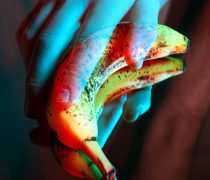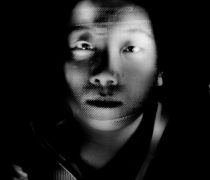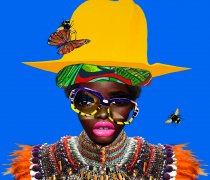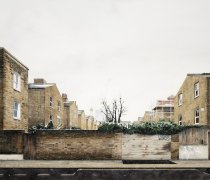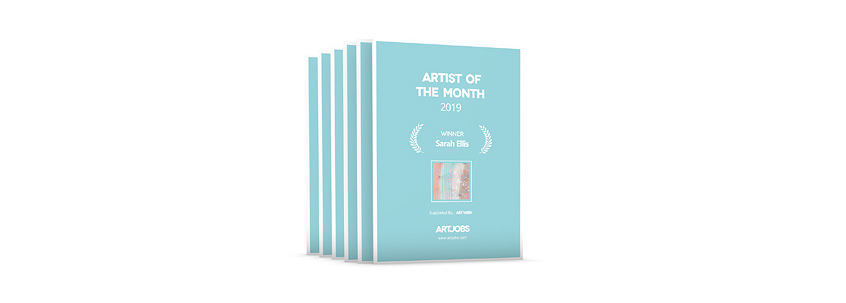- Jobs
- Open Calls
- Events
- Learning
- More
- SUBMIT
Rikardo Druškić-Jekić
Country where you live:
- Bosnia & Herzegovina
City where you live:
- Sarajevo
Website:
Statement :
My art is my guide in the search for the meaning of life and the truth that moves me along the way. I see life through art, and art through life. I use my creativity as a means of communication, first with myself and then with the rest of the world. I use the freedom of the artistic narrative to create my world. Within that world, I paint my visions, I deal with the articulation of my inner world, and the transmission of my ideas. Inclusion, which is an integral part of my creativity, I would divide into two parts: internal and external. On the one hand, my work invites you to explore and accept your dark side and the demons that dwell there. Only then can a person be a complete being and a master of its house. On the other side, my art is inclusive, because it gives space for a normal and equal life to people who were never accepted in society and who were stigmatized and forgotten by contemporary inclusion. These are " crazies, fools, lunatics, black sheep, weirdos", people who for various reasons could never fit into society. They are depicted as superheroes in my works. Although I love the time I live in, I also see its great flaws. Through my art, I invite modern man to a different system of values than the material one in which he lives. In it, God, love, honor, truth, honesty, spirituality and beauty are in the first place. Symbols and myths are my way of communication. My creative process often lasts for several months. The world I create is the world I imagine. It is a world full of diversity, but in which everyone lives together. Hieronimus Bosch, Karl Gustav Jung and indigenous traditions influenced my art the most.
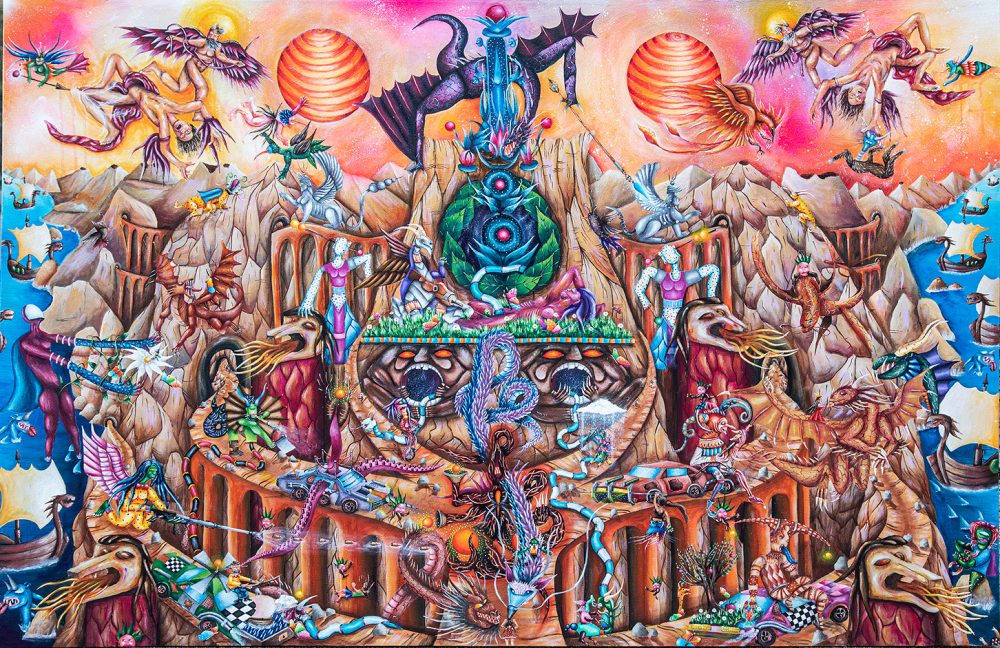
CHAOS IS RESULT UPON WHICH REALITY IS WRITTEN
This work was created for almost two months. For those two months, this piece received my ultimate attention. I thought about every single detail. Within one big story, there are many smaller ones, and all of them together form one big whole. The complexity of these works and well-organized chaos is the best description of my mind and the way I look at the world. Through this cycle, "Embodiment of the Invisible", I deal with my inner world, and all this through symbols, mythology and my grotesque beings. Inclusion is a new dimension of this cycle, the one that perhaps gives it the greatest quality. I would divide inclusion into internal and external. On the one hand, these grotesque characters invite you to meet AND accept AND love your inner demons. They are integral parts of us. There is no complete and self-realized person who does not do this. On the other hand, through the freedom that the artistic narrative gives me in my works, I want to combine polarities; east and west, old and new, beautiful and ugly, small and large. In my world, everyone has the opportunity to live together. One of the big problems of the time we live in is the lack of respect for differences. Technologies, and especially social networks, have shown all the tribal origins of man. We live in a time of greatest polarity. My wish is to show through my art the importance of understanding and paying attention to the ideas, passions and emotions of other people, no matter how different they are from us. Apart from God, there is no There is no one universal truth. These truths change in relation to experience, character and temperament. If we want our being to gain understanding. respect and validation, then we have to give it too. I think that art should be used as a universal medium through which people come together. It should be a free space in which opposing ideas and attitudes circulate freely.
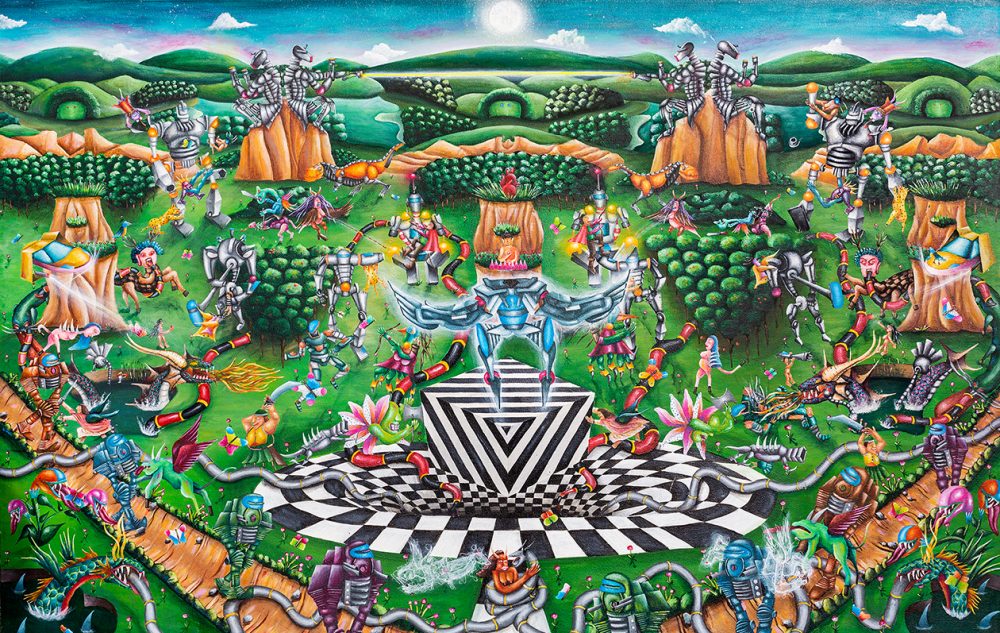
FIGHTING FOR HEAVEN
The plot of this story is set in the distant future. Robots took over the planet Earth, and after that they also conquered heaven. The place where the action takes place, "paradise", is actually a small part of the landscape started by Hieronimus Bosch, which I, with the help of artificial intelligence (Ps), expanded and made bigger and mine. The original painting, the one you could see in the post published recently, is the left part of Bosch's triptych "The Last Judgment". The left panel shows the Garden of Eden, at the top of which God is shown sitting in the sky, while the rebellious angels are cast out of the sky and turned into insects. At the base of the panel are Adam and Eve. The question that probably comes to mind is: "Where do the robots come from in paradise?" It's actually part of a big idea, where I want to insert my robots into mythical stories from the past. Myths, as a narrative, are encoded with a much greater meaning than at first glance. Myths are sacred stories that explain the world and human experience. They are as relevant to us today as they were to people from the distant past. Myths answer timeless questions and serve as a moral compass for every generation. Myth, like a dream, can be considered the birthplace of conscious abstract knowledge, the matrix from which formed ideas spring. Every concept, no matter how new or modern it may seem, emerges from the soil prepared by centuries of previous intellectual activity. Modern, rational man, most often sees myths as superstitious stories and rejects their importance. Yet myths are all around us.
The cycle "Mundus Novus" deals with the issue of artificial intelligence. Although this idea is much bigger than the robots that I paint, it can be metaphorically presented most easily in the artistic narrative through them. This cycle is also autobiographical. Robots represent the rational part of me. They represent my logic, order, work and discipline. The work is conceived in the form of symmetry consisting of robots on the left and right, and one central, main robot in the middle. Robots are depicted as big, strong and powerful. They are painted in harmony and harmony. They are actually gods, who have taken over heaven. In the background are the mountains on which they are sitting and which represent Mount Olympus, the home of the 12 Greek gods.The beings that oppose the robots represent humans, mortal and sinful. On that side, my art is inclusive, because it gives space for a normal and equal life to people who were never accepted in society and who were stigmatized. These are "fools, lunatics, black sheep, weirdos", people who, for various reasons, could never fit into society, and who were made to feel less valuable by that very society because they did not obey the imposed social norms. They are depicted as superheroes in my works. Throughout my life, I worshiped and loved such people, I saw myself in them and found inspiration, and selfishly used them for my own validation. Just as the idea of a robot is split in two, so are these creatures. On the one hand, they represent us people, and on the other hand, they represent my personal subconscious, irrational content. That's how these characters are created. They are created by the automatic method, without any thinking or raids in the process itself. In his manifesto, written in 1924, Andre Breton talks about this process that characterizes surrealism. I never correct the characters that come from the darkness of my subconscious, every move comes without thinking about whether it will be beautiful.
The central idea of the work is represented by a black and white hole. Inside the hole is the subconscious content, and its duality is shown in black and white. The concept of the black and white hole is such that subconscious content enters it, and conscious content comes out, if the original is properly processed with the help of raids. I have shown this process with the motif of a snake. A large monstrous snake enters the hole, and a robot snake emerges from it, which later clashes with a new monster. The perfect harmony of the robots is spoiled by these strange creatures. The symmetry would be perfect if it weren't for the chaos they introduce. This is manifested on the black and white cube in the middle of the work, which is moved from the perfect central alignment by the angel and thus disturbs the perfect harmony.
An imaginary line is drawn through the central part of the work. It represents the path of my life, from darkness to light, with the help of reason (central robot) and God (Buddha). The central robot has no head, and above it is a Buddha, whose lower body is missing. They only make a whole together. I wanted to show the importance of both rational and irrational in man. Radio is my guide through life, it gives me support and structure. I often overcome my dirty heart, jealous and vain, precisely with the help of raids. Likewise, if I were to stay within the boundaries that he creates, I feel that I would miss out on the most beautiful magic of life, for which I am constantly searching as a man and an artist. I'm not ready for that.
In this work I also played with motifs that create a sense of illusion. If you look closely, three characters are hidden in the background. One of them, the central one (through which the imaginary line passes) is me. Their heads are circles, and on their heads is bush hair. The body is represented by a brown mountain, and the feeling of the hands is obtained by looking at the mountains. Symmetry also hides the idea of parallel worlds (The Many World Interpretation). The MWI of quantum mechanics believes that there are many worlds that exist in parallel in the same time and space as ours. The idea of quantum coupling claims that two identical particles can be in two different places, just depending on which one you look at. Hence the same characters, on the left and on the right. The only thing that differentiates them is their different interaction and its outcomes. On the left is Adam in the hands of a robot, defeated. On the right, Adam stole the robot's arm, making it weaker. If these ideas make you feel freaked out, that's good. Even the best scientists have only scratched the surface of quantum mechanics, but the insights these ideas can lead to are incredible, and these ideas are a great inspiration for artists around the world.
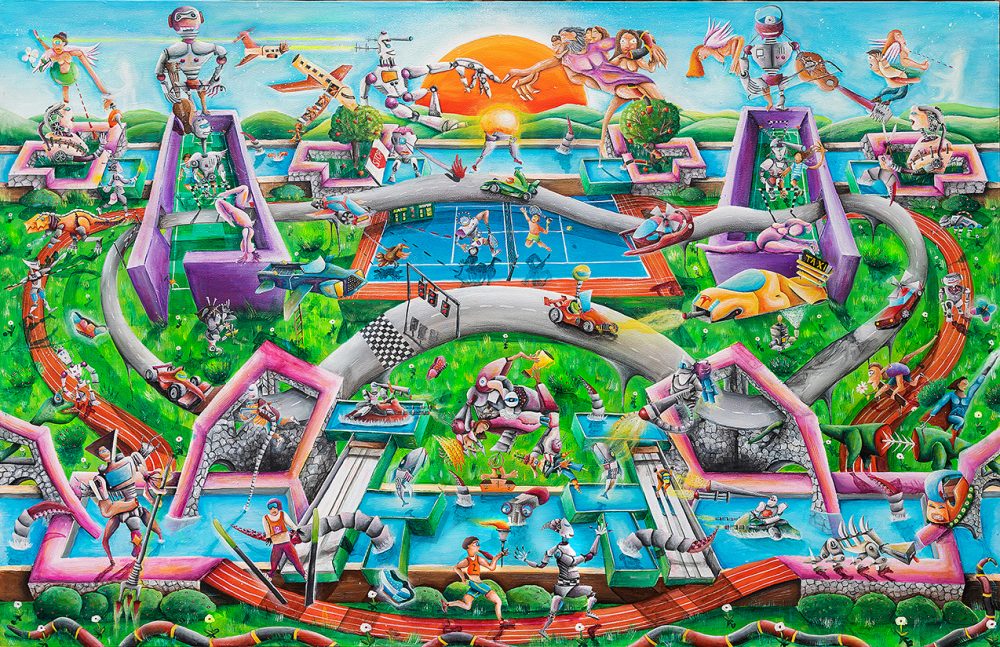
MUNDUS NOVUS
The theme of this work is artificial intelligence. The main idea from which I started the work is on the upper central part. It is a tribute to Michelangelo's work ``Creation of Adam''. That work is a fresco that forms part of the ceiling of the Sistine Chapel, painted c. 1508–1512. It illustrates the biblical story of creation from the Book of Genesis in which God gives life to Adam, the first man. I replaced Adam with a robot, and thus set the central topic: ``The arrival of artificial intelligence'', and then I asked a question; What is its role and what are the potential outcomes of the automation process? In the work itself, the answers are illustrated through various interactions of the characters; robots and people. The title of the work says that the world as we know it will soon be gone. One of his main messages is the necessity of preparing humanity for the technological revolution!
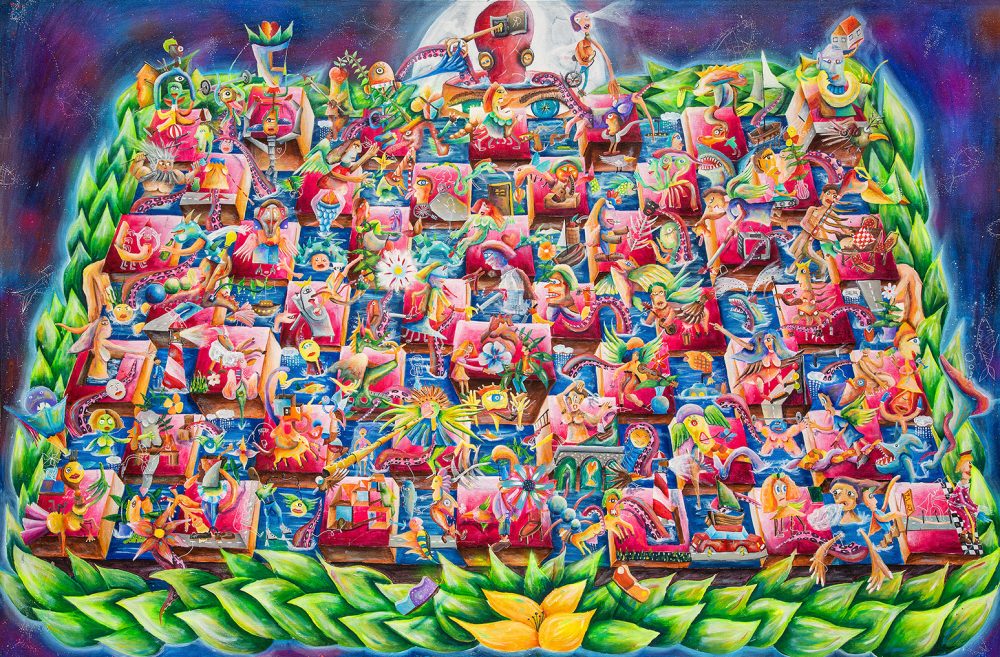
PARTS OF THE UNKNOWN
This work represents a part of that transcendental process ``Subconsciousness - Consciousness''. On the canvas are the characters that I drew for months, without thinking about their appearance and form. I didn't care about beauty. I let myself go into the dark, and then later shaped and arranged that mess into this work of art. The concept of the work was conceived in such a way that I, Ricardo, this central figure under the moon, with blue eyes, hold this surface and observe what is happening on it. That surface is comprised of cubes that symbolically, because they are on the surface, represent the consciousness and the sea (symbol of the subconscious) around them, from which these characters came and climbed to the surface. These characters represent part of the contents of my subconscious, which I called ``Parts of the Unknown''. The octopus, as an animal that lives in the depths, but also has the ability to climb to the surface, served as a symbol for that process. At work, she uses her arms to place or has already placed the dark content on the surface, thereby arranging at least part of the darkness from which these, often grotesque, morbid characters were created.
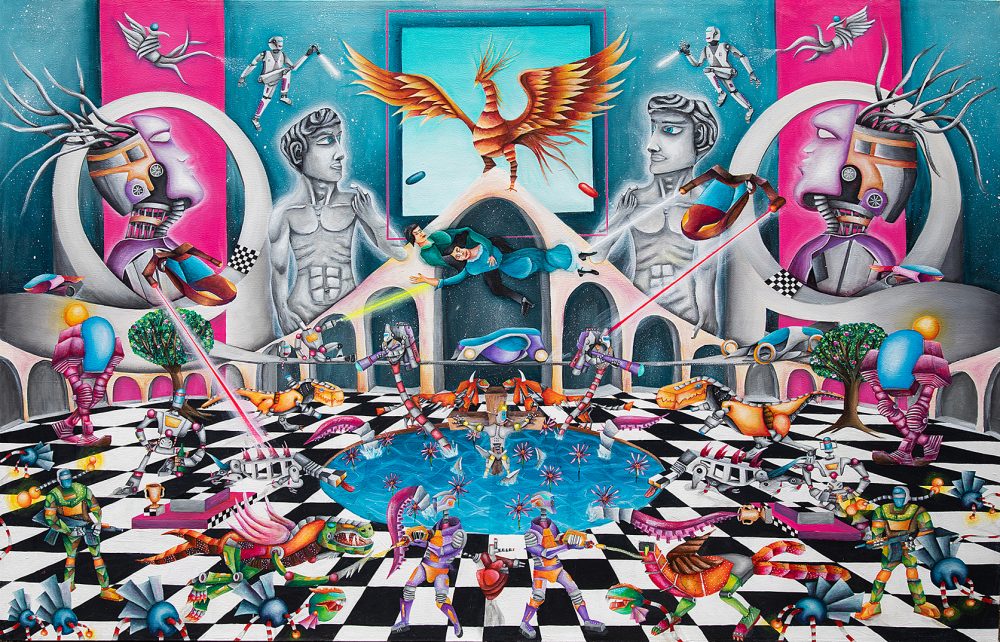
ONLY LOVERS LEFT ALIVE
In this painting, the artist depicts a dystopian world - a world of chaos and disorder. In the central part of the composition, the motif of Chagall's lovers from the painting "Above the City" is incorporated. Chagall and his Bella, united in their love, float over a city completely ruled by robots, and they are also the only two surviving human beings in this chaotic world. Compositionally, this painting resembles the central part of Bosh's triptych "Garden of Earthly Delights". The composition is divided into two parts by an aqueduct. In the central upper part, on the aqueduct, a phoenix is shown, which symbolizes reawakening, birth, renewal and transformation. Below the phoenix, on the right and left side, there is one pill each, which is a reference to the movie Matrix. We know the scene where Neo has to choose between the blue pill and the red pill; the red pill would reveal the truth to him, i.e. make him wake up in the real world, and the blue pill would return him to the dream and illusion of the false world. The blue and red pill in pop culture symbolize the choice between the state of illusion and dream and the acceptance of truth and painful reality. With this reference, Ricardo raises the question whether it is better to free the mind with the truth or to live in blissful ignorance. In the upper part of the composition, above the aqueduct, on the right and on the left we can see marble statues representing Michelangelo's David. "David", a masterpiece of Renaissance sculpture, is a symbol of human strength and signifies the pinnacle of human skill and the realization of ideals. This reference to Renaissance art can also be connected to the phoenix symbol, as Renaissance art signifies rebirth. The lower part, the "ground" of the composition, is a chessboard on which characters, robots and robot-like animals, such as pawns, are chaotically scattered. We can notice that a dangerous and uncertain game is being played on this chessboard, and each move has its positive and negative side that will affect the entire cosmos of ideas on the chessboard. Chess is like the universe in miniature and symbolizes life. The chessboard represents the field of possible reality, and the black and white fields create a game of contrasts. In the central part of the chess board there is a source of water, which symbolizes spiritual purification, renewal and positive energy. In the center of the fountain is a robot crucified on a cross as a symbol of Christ's crucifixion leading to rebirth. This picture is also thematically connected to the central part of Bosh's triptych, because Rikardo, just like Bosh, represents a chaotic world in which disharmony reigns and the absence of hierarchy, where man no longer rules over other living creatures. This image symbolizes the beginning of the new and the end of the "old" world as we know it now.
Bio:
About
Rikardo Druškić was born in 1990. in Zagreb and has spent all his adult life living in Sarajevo. His interest for art began during high school years with main focus on illustration and digital art. Rikardo uses combination of art techniques such as painting, street art, drawing and digital art. His works have been exhibited, both independently and in collective exhibitions in many art galleries and public spaces in the world such as: Sarajevo, Mostar, New York, Miami, Los Angeles, Dubai, Taiwan, Berlin, Brussels and Vienna. He was one of the finalists in the Art Revolution Competition Taipei in 2014 and the same year his works Madness Continuous and Depth were selected by visual art platform see.mee to be presented at the famous Times Square in New York. First solo exhibition Tales of Love took place at the Gallery Boris Smoje in 2014. in Sarajevo. Later that year the same exhibition was presented in Memorial Home of Svetozar Corovic in Mostar. One of his most significant professional exhibitions were: “Initiation”, Collegium Artisticum – Sarajevo, Gallery 25N – New York, “The Wall” – Historical Museum in Sarajevo, Post-election Trauma – Sarajevo, “Where is the Exit” – Gallery JAVA in Sarajevo, “Diggin”, Maineouevre – Berlin. Some of his projects include illustrations of the books as well. He was one the main participants of the first Festival of Street Art (FUU) in Sarajevo, during which his creative work was transmitted into public space. After that, he soon joined forces with the important street art initiative for Mostar Street Art Festival. In 2016 he was invited to paint a mural inside the Sarajevo Youth Theater expanding his field of interest into the world of public art. Next step was first video exhibition Children Joy in Sarajevo projected on 1000m2 screen. Exhibition “Suscitans Conscientia” was held in City Hall of Sarajevo which marks the beginning of his new artistic expression and plans for the two new exhibitions in Brussels and Vienna. In 2019 he painted a mural in Brussels and in 2020 started residential program at Almuñécar, Spain. In february, Rikardo paints a replica of an airplane from WW2, which is exhibited in Historical Museum of BiH in Sarajevo. Later on, for the birthday of his hometown Sarajevo, he organises exhibition “Was is Walter“, where the “replica“ was firstly shown to the public. During the start of the Covid Pandemic, Rikardo makes his first video exhibition, through which he collects money for a charity organization “Pomozi.ba“. After that he starts working on his new project “Awakening Solidarity“, in which he paints 5 murals in 5 different cities in Bosnia&Herzegovina. Rikardo lives and works in Sarajevo.
Solo Exhibitions
2014 “Tales of Love”, Gallery Boris Smoje, Sarajevo
2014 “Tales of Love”, Memorial Home Svetozar Corovic, Mostar
2015 “Where is the Exit”, JAVA Gallery, Sarajevo
2016 “Children Joy”, Video Exhibition, Sarajevo
2017 “Digginside”, maineouevre, Berlin
2017 “Homage to the Past”, Kutcha, Sarajevo
2018 “Suscitans Conscientia”, City Hall, Sarajevo
2019 Bozar Cultural Center, Brussels
2019 Film studio Sabotage, Vienna
2020 Awakening Conciousness, Historical Museum of BiH , Sarajevo
Group Exhibitions
2013 Group Exhibition, Los Angeles Center for Digital Arts (LACD)
2013 “Initiation”, Collegium Artisticum, Sarajevo ( work selection by Jusuf Hadzifejzovic) 2014 Gallery 25N, New York
2014 “The Wall”, Historical Museum, Sarajevo
2014 “Post-election Trauma”, Bosnian Cultural Center, Sarajevo
2014 Art Revolution Competition, Taipei
2015 “Visuals for Museum”, National Museum of Bosnia and Herzegovina
2016 “Add to Cart”, Books.ba, Sarajevo
2018 “Bosnian Contemporary 100%“, Brodac Gallery, Sarajevo.
2020 “Was is Walter?“, Historical Museum of BiH , Sarajevo.
2020 “Feed your Demons“, ONE project, London
Murals
2015 Homage to Srebrenica genocide, Historical Museum of BiH
2016/2018 Festival of Street Art (FUU)
2016/2018 Mostar Street art Festival
2016 The Puppet Theater Mostar
2016 Sarajevo Youth Theater
2017 Pop Up Sarajevo
2019 Brussels, Balkan Traffik Festival
2020 Awakening of Solidarity: Sarajevo,Gorazde, Trebinje, Zenica, Derventa
|
United Kingdom Cheltenham |
United States New York |
United Kingdom london |
United Kingdom london |
United States Alameda |
Pages
- « first
- ‹ previous
- …
- 44
- 45
- 46
- …
- next ›

